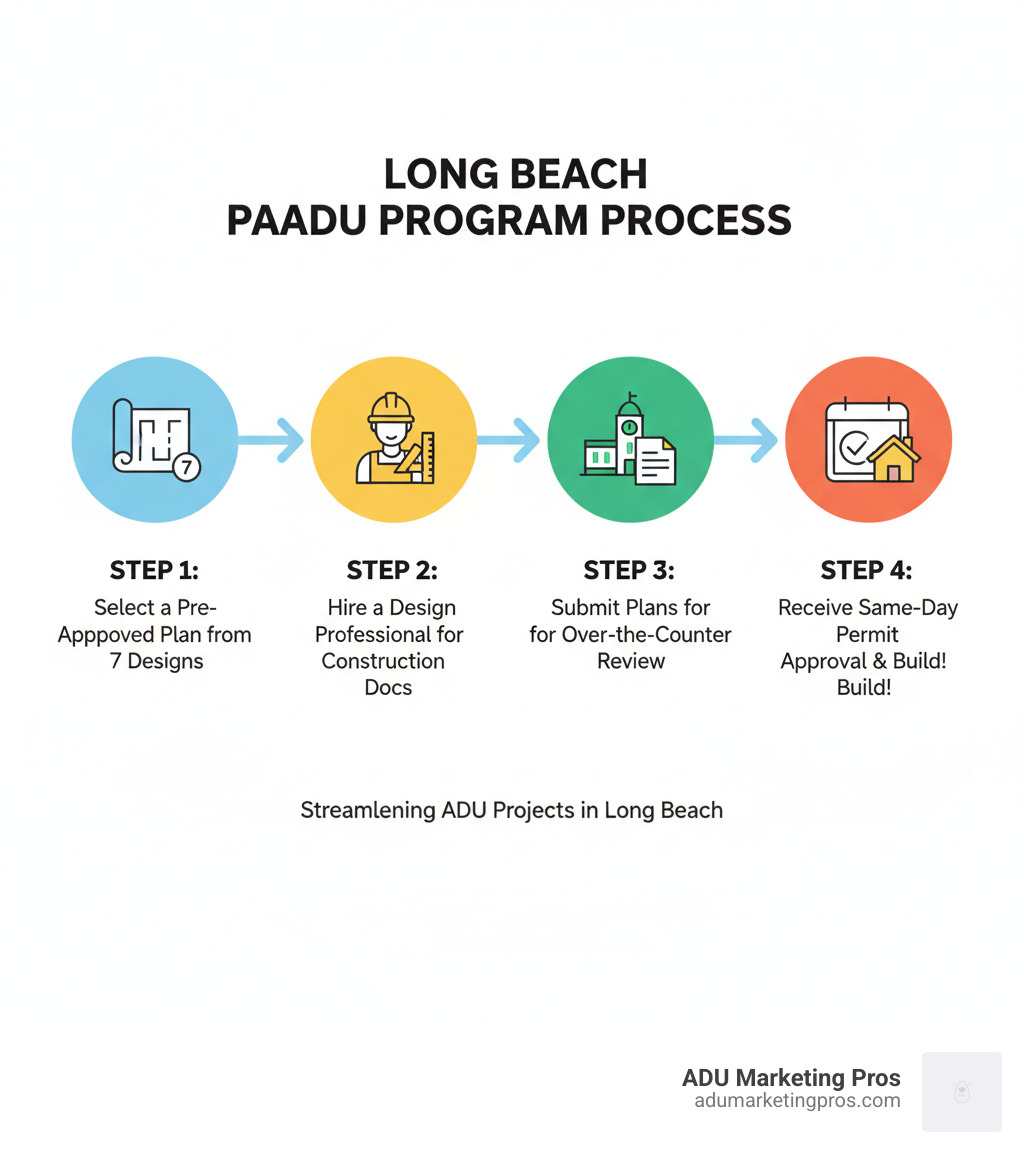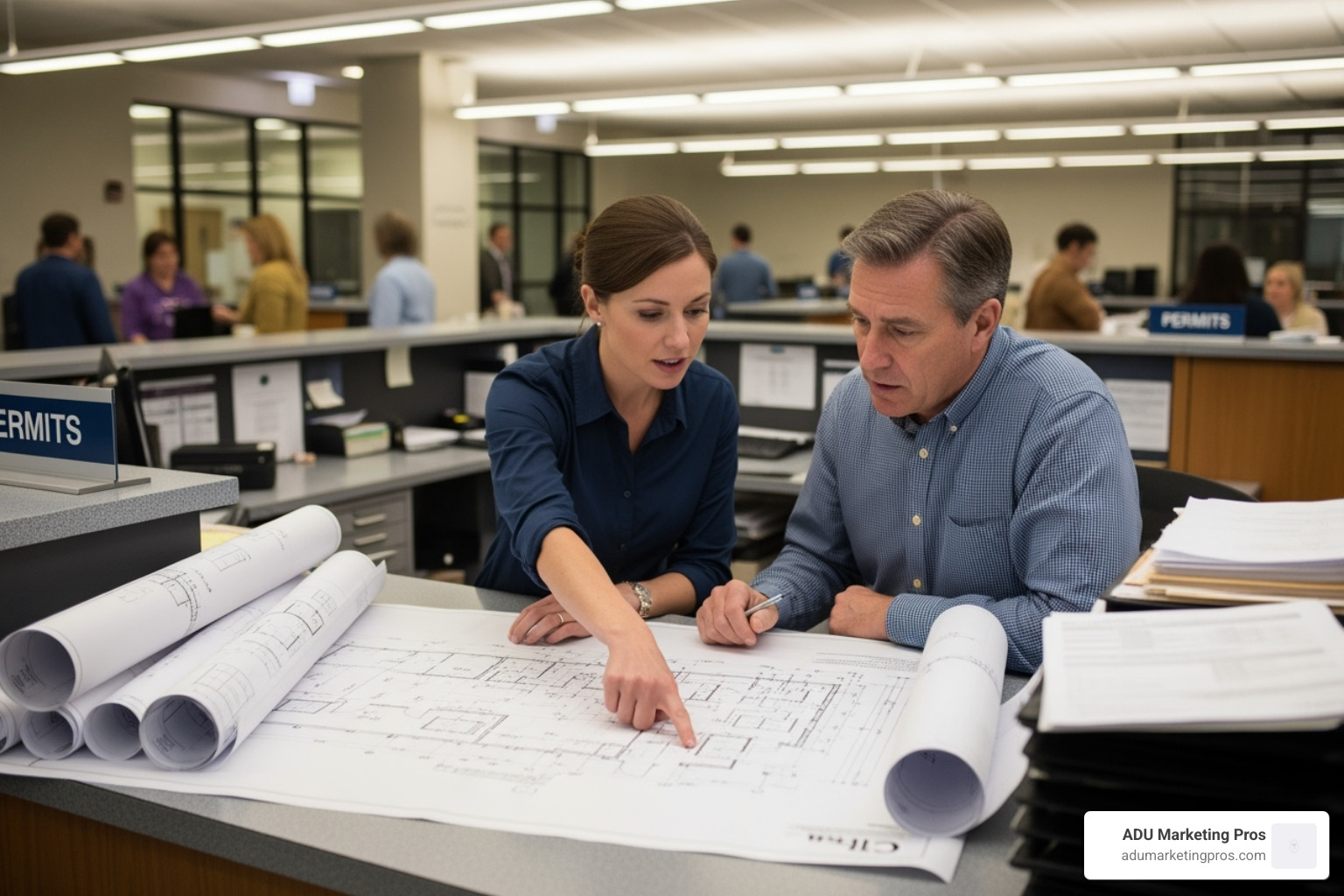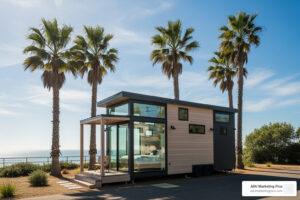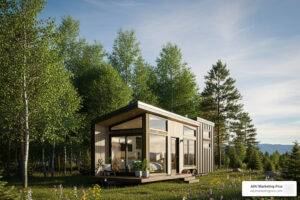Streamlining Your ADU Project in Long Beach
Building an ADU in Long Beach is now faster and more affordable thanks to the city’s innovative Pre-Approved Accessory Dwelling Unit (PAADU) Program. This initiative provides homeowners with access to city-vetted Long Beach ADU plans, cutting through red tape and streamlining the entire building process.
Quick Access to Long Beach ADU Plans:
- Official Source: Long Beach PAADU Program webpage
- Available Plans: 7 pre-approved designs (PAADU 1-7)
- Plan Types: Single-story, freestanding ADUs under 1,200 sq ft
- Cost Range: $1,100-$1,600 for plan purchase
- Timeline: Same-day permit approval possible
- Contact: Omid Dadfar at 562.570.6447
As part of its strategy to create over 26,500 new residential units by 2029, Long Beach is championing ADUs, with a goal of adding up to 500 new units per year. The PAADU program is central to this effort. Instead of a standard plan review that can take months, homeowners using pre-approved plans can potentially receive same-day over-the-counter approval.
Superintendent David Khorram notes the program “can provide an incentive to owners and help them realize the dream of an ADU, potentially saving weeks or months from plan submission to permit issuance.” This accelerated timeline not only saves time but also thousands of dollars in plan check and engineering fees, making ADU construction a viable option for more families looking to add rental income, house relatives, or increase property value.

What is the PAADU Program and How Does It Benefit Homeowners?
The Pre-Approved Accessory Dwelling Unit (PAADU) Program is Long Beach’s solution to simplify ADU construction. It eliminates the long delays and high costs typically associated with custom building projects by offering a catalog of professionally designed, city-approved plans.
Instead of starting from scratch, homeowners can select a plan that has already passed the city’s rigorous review process. The primary benefit is speed: while custom designs often wait in review for 60 days or more, Long Beach ADU plans from the PAADU program can be approved in as little as four weeks, with some qualifying for same-day permit approval.
This streamlined approach is a key part of the city’s strategy to address its housing shortage. By making the process faster and more affordable, Long Beach encourages more homeowners to add housing units to their properties. The city’s announcement of the program highlights its commitment to making ADU construction accessible to a wider audience.
The Core Benefits: Time and Money
The PAADU program’s main advantages are significant savings in both time and money. A faster permitting timeline allows construction to start sooner, which means a quicker path to housing family members or generating rental income.
- Time Savings: Custom ADU plans typically require 60 days or more for city review. PAADU plans can shorten this to about four weeks, with the possibility of same-day approval.
- Financial Savings: Custom architectural plans can cost $4,000 to $10,000 or more. The pre-approved Long Beach ADU plans cost between $1,100 and $1,600, offering thousands in immediate savings. This doesn’t include additional savings from reduced plan check fees and engineering costs.
Faster permitting also reduces soft costs associated with project management and construction delays. For a complete overview of expenses, see our guide on Long Beach ADU Cost.
How the Program Addresses Long Beach’s Housing Needs
The PAADU program is a critical component of Long Beach’s plan to solve its housing crisis. As mandated by the state’s Regional Housing Needs Assessment (RHNA), the city must create 26,500 new housing units by 2029, and ADUs are expected to contribute 400 to 500 new units each year.
ADUs provide “gentle density,” a strategy that adds homes to existing neighborhoods without drastically changing their character. Unlike large, multi-story apartment buildings that can alter a community’s landscape, ADUs are integrated into single-family lots, preserving the neighborhood feel while creating much-needed housing. They create affordable housing options for renters—from students and young professionals to seniors looking to downsize—and new income streams for homeowners. By removing common barriers to construction like high design costs and long review periods, the PAADU program accelerates this process, helping Long Beach meet its ambitious housing goals one backyard at a time.
Exploring the Pre-Approved Long Beach ADU Plans
Finding the perfect Long Beach ADU plans is simple with the PAADU program. Instead of commissioning a costly custom design, you can browse a curated selection of plans that are already approved by the city.

Your first stop should be the official PAADU program webpage, which showcases all available designs. Once you find a plan you like, you purchase the construction documents directly from the original architect, such as Olfati Design Group or Long Beach Designers. These local firms have designed the plans to be all-electric, single-story, freestanding units under the 1,200 square foot maximum, ensuring they fit well on most residential lots.
Available ADU Types and Layouts
The program offers a variety of layouts, from compact studios to family-friendly two-bedroom units, each with a distinct style.
-
Olfati Design Group offers “The Casita,” a 415 sq. ft. one-bedroom unit with a covered porch that extends the living space outdoors, creating an ideal spot for a morning coffee or evening relaxation. Its efficient layout makes it perfect for a single renter, a home office, or a guest suite. They also provide “The Sevila,” an 800 sq. ft. two-bedroom, two-bath design. This larger unit is well-suited for a small family or a co-living arrangement, featuring a primary suite with a walk-in closet and a spacious open-concept living area.
-
Long Beach Designers contributes a 563 sq. ft. one-bedroom unit designed with numerous windows to maximize natural light, creating a bright and airy feel. Their larger option is an 876 sq. ft. two-bedroom, two-bath unit that embraces indoor-outdoor living with a large covered patio and a wide sliding door entrance, perfect for enjoying the Southern California climate.
Understanding the Costs of Pre-Approved Plans
The PAADU program offers clear, upfront pricing that helps with budgeting.
-
Plan Purchase Costs: Olfati Design Group’s plans range from $1,100 to $1,600. Long Beach Designers’ plans are estimated around $10,000, which is still significantly less than a fully custom design of similar scope.
-
Estimated Construction Costs: As a baseline, budget around $250 per square foot for construction. This puts a smaller unit like “The Casita” at approximately $103,000 to build, while a larger 876 sq. ft. unit could cost around $219,000. These are “hard costs” for labor and materials.
-
Budgeting for Soft Costs: You’ll also need to budget for “soft costs,” which are essential pre-construction expenses. These include city permit fees, school district fees, and utility connection charges. Additionally, you may need to pay for a site survey to map your property, a soils report to inform foundation design, and structural engineering calculations. Choosing a PAADU plan reduces some of these costs but doesn’t eliminate them entirely.
By choosing a pre-approved plan, you are already saving thousands on design fees, making the overall project more affordable. For more on funding your project, explore our guide on Long Beach ADU financing.
Pre-Approved Plans vs. Custom Architect: Which is Right for You?
Choosing between pre-approved Long Beach ADU plans and a custom design is a key decision. The right path depends on your budget, timeline, and specific needs. There’s no single correct answer, but understanding the trade-offs will help you decide.
Here’s a comparison of the two approaches:
| Feature | Pre-Approved ADU Plans | Custom Architectural Plans |
|---|---|---|
| Cost | Lower upfront cost for plans ($1,100 – $10,000). | Higher upfront cost for plans ($4,000 – $20,000+). |
| Timeline | Significantly faster permit approval (4 weeks, same-day OTC possible). | Slower permit approval (typically 60+ days for review, plus design time). |
| Customization | Limited; best used “as-is” to retain benefits. Minor alterations risk losing expedited review. | Unlimited; custom to your exact needs, preferences, and site. |
| Best Use Case | Rental income, guest house, straightforward additional living space. | Multi-generational living (e.g., aging parents with accessibility needs), unique property challenges, specific aesthetic goals. |
| Permit Process | Streamlined, over-the-counter (OTC) review. | Standard review process, potentially requiring multiple revisions. |
When to Choose Pre-Approved Long Beach ADU Plans
Pre-approved plans are the ideal choice when efficiency, speed, and affordability are your top priorities.
- For Rental Income: A faster timeline means you can start collecting rent sooner, improving your return on investment.
- On a Tight Timeline: If you need housing for family members quickly, the potential for same-day permit approval is a major advantage.
- With Budget Constraints: Lower plan costs and reduced permit fees free up funds for construction and finishes.
- For Simplicity: If a standard layout meets your needs, a pre-approved plan avoids the complexity and decision fatigue of a custom design.
When to Hire a Custom Architect
In some cases, the flexibility of a custom design is essential and worth the additional time and investment.
- For Specific Family Needs: Customization is crucial for features like wheelchair accessibility, roll-in showers, or other modifications for aging parents or family members with unique needs.
- For Unique Lot Constraints: An architect can design a solution for an unusually shaped or sloped lot, or to work around existing trees and structures.
- For a Personalized Design: If you have a specific aesthetic vision or want the ADU to perfectly match your main home’s style, a custom architect is the best choice.
- To Maximize Property Value: A unique, high-quality custom ADU can become a standout feature that significantly boosts your property’s market value.
If you’re leaning toward a custom build, work with experienced professionals. Learn more about finding the right team in our guide to Long Beach ADU Builders.
Navigating Regulations, Permits, and Construction
Even with streamlined Long Beach ADU plans, understanding the permitting process is key to a successful project. The PAADU program simplifies this, but knowing the rules will empower you as a homeowner.

Long Beach uses a ministerial approval process for ADUs, meaning applications are reviewed against objective standards, not subjective opinions. If your plans meet the code, they must be approved. The PAADU program improves this with an Over-The-Counter (OTC) review at the Development Permit Center in City Hall. After a design professional adapts a pre-approved plan to your property, you can submit it for this expedited review. For more details, see our guide on Long Beach ADU Permits.
Key Zoning and Setback Regulations
Long Beach’s ADU rules align with homeowner-friendly state laws. Always consult the official Long Beach Municipal Code for ADUs for the most current information, but here are the key takeaways:
- Setbacks: New detached ADUs require only 4-foot side and rear yard setbacks, providing great flexibility. Note that building code may require special fire-rated construction for walls and eaves within 5 feet of a property line. Converted structures can often maintain their existing, non-conforming setbacks.
- Height: ADUs can be built up to at least 16 feet high, with the city often permitting detached units up to 24-25 feet, depending on the zoning of the underlying property.
- Lot Size: There is no minimum lot size requirement to build an ADU.
- Parking: One parking space is generally required, but exemptions are common. You are exempt if your property is within a half-mile of public transit (like a bus stop), in a designated historic district, or if you are converting an existing structure (like a garage). Junior ADUs (JADUs) do not require additional parking.
The Permitting Process and Timeline with PAADU
The PAADU program’s main advantage is its accelerated timeline. A design professional will first create site-specific construction documents based on your chosen pre-approved plan. These documents show how the ADU fits on your lot, its foundation design, and how it connects to utilities.
With these plans, you can bypass the standard 60-day review for custom projects. PAADU projects target a four-week turnaround, and many qualify for same-day permit issuance via OTC review. This speed reduces holding costs and allows you to start construction much sooner.
Budgeting for Total Construction Costs
Your total project budget will consist of hard and soft costs.
- Hard Costs: These are the direct costs of construction, including labor and materials. A reasonable starting estimate for Long Beach is $250 per square foot, though this varies with finishes and market conditions.
- Soft Costs: These include all other expenses, such as permit fees (which are reduced with PAADU), utility connection fees, and school district impact fees.
To help offset these expenses, look into available incentives and grants. The CalHFA ADU Grant Program, for example, offers up to $40,000 to eligible low-to-moderate income homeowners to cover pre-development and non-recurring closing costs. These are the upfront expenses like architectural designs, engineering, and permit fees that often pose the first major financial hurdle. Check with state and city agencies for the latest programs and eligibility requirements.
Frequently Asked Questions about Long Beach ADU Plans
Building an ADU is a big project. Here are concise answers to the most common questions about Long Beach ADU plans and the PAADU program.
Can I make changes to a pre-approved ADU plan?
While you can make changes, it’s generally not recommended if you want to retain the benefits of the PAADU program. The plans are pre-approved “as-is” to ensure a fast-tracked process.
- Major modifications like changing the footprint, roofline, or overall layout will almost certainly require a standard plan review, eliminating the time and cost savings.
- Minor cosmetic changes like paint colors or fixtures are usually acceptable, but any structural alteration risks pushing your project into the slower, more expensive standard review process.
For maximum efficiency, it’s best to use the plans as designed. If you require significant customization, hiring a custom architect from the start is a better path.
Can I rent out my ADU?
Yes. One of the primary benefits of building an ADU is the ability to generate rental income. Long Beach encourages long-term rentals (30 days or more) to help address the local housing need. Short-term rentals (like Airbnb) are generally prohibited for ADUs in Long Beach and most California cities.
Depending on size and location, a new ADU in Long Beach can generate significant monthly rent, often ranging from $2,200 to $2,800 or more. This income can help offset construction costs and increase your property’s overall value by changing it into a multi-unit asset.
How many ADUs can I build on my property?
The number of ADUs you can build depends on your property type.
-
Single-Family Homes: You can typically build one detached ADU and one Junior ADU (JADU) on a property with a single-family home. A JADU is created by converting existing space within the main house and must be 500 sq. ft. or less.
-
Multi-Family Properties: Owners of multi-family properties can build up to two detached ADUs on the lot. Additionally, you can convert existing non-livable spaces (like storage rooms or garages) into more ADUs, generally up to 25% of the existing number of units.
Recent state laws like SB9 may offer further opportunities for lot splits and additional units, highlighting California’s commitment to increasing housing density. Always consult with a professional to understand the specific rules for your property.
What are the specific requirements for a Junior ADU (JADU)?
A Junior Accessory Dwelling Unit (JADU) is a specific type of ADU with its own set of rules. It’s an attractive option for homeowners looking to add a small, efficient unit with minimal construction.
- Location: A JADU must be created within the existing, approved walls of a single-family residence. This often involves converting a spare bedroom, an attached garage, or another underutilized space.
- Size: A JADU cannot exceed 500 square feet.
- Kitchenette: It must contain an “efficiency kitchen,” which includes a sink, cooking appliance, counter space, and storage.
- Entrance: It must have its own separate exterior entrance.
- Bathroom: It can have its own bathroom or share a bathroom with the main residence.
- Owner Occupancy: The property owner must reside in either the remaining portion of the primary residence or the newly created JADU. This requirement does not apply to standard ADUs.
Conclusion: Take the Next Step on Your ADU Journey
Building an ADU in Long Beach is more accessible than ever. The city’s PAADU program provides a clear, efficient, and affordable path for homeowners to expand their living space and invest in their property.
The pre-approved Long Beach ADU plans offer significant benefits:
- Time Savings: Cut months off your project timeline with an expedited review process and the potential for same-day permit approval.
- Cost Reduction: Save thousands on architectural and engineering fees, making your project more financially feasible.
- Simplified Process: Move forward with confidence using designs that have already passed city review.
An ADU is a smart long-term investment, whether you’re housing family, creating a home office, or generating rental income. It adds both functional living space and substantial value to your property.
At ADU Marketing Pros, we connect homeowners with experienced ADU professionals who can turn these pre-approved plans into reality. Your property holds untapped potential, and Long Beach’s forward-thinking program makes it easier than ever to open up it.
Ready to see what’s possible? Explore more ADU floor plans and design ideas to find inspiration for your Long Beach property.




